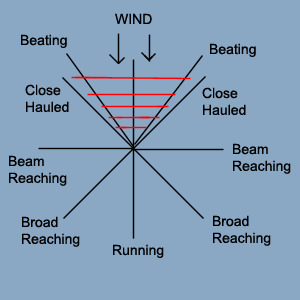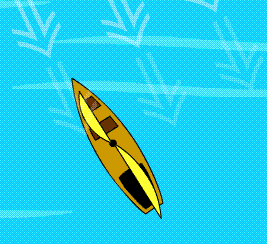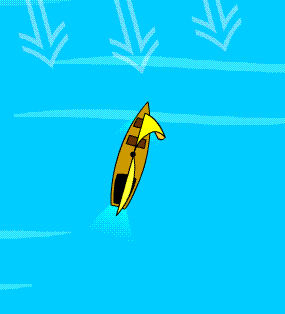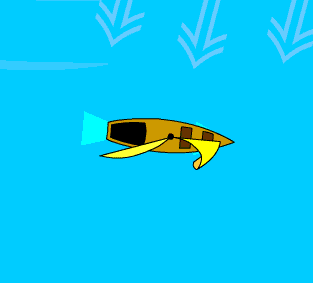Everything You Need To Know About The Points of Sail
Knowing what to do when you change direction is very important in sailing and so you should know the points of sails and what you as the crew and helm have to do to trim and optimise the boat for this course relative to the wind.
Below are the points of sail, where they are relative to the wind, what speed the boat goes at and a summary of what you should do at each...
- Head to Wind: 0 - 30 degrees off the wind. Full stop or moving backwards. Worst possible point of sail.
- Beating: 40 - 45 degrees off the wind. Very likely to be slightly heeled and both crew and helm leaning out of the boat. All sails tightly in.
- Close Hauled: 45 degrees off the wind. Slightly faster than beating. Helm still sitting up, but crew is probably in the centre of the boat depending on wind strength. Sails one quarter out.
- Beam Reaching: 90 degrees off the wind. Fast point of sail. Helm sitting on bench and crew sitting in the middle or leeward side. Sails half out.
- Broad Reaching: 135 degrees off the wind. Usually the fastest point of sail. If spinnaker is up helm is on the mainsail side and crew is hiked out the boat. Otherwise the helm is sitting on the bench and crew is sitting with the mainsail. Sails three quarters out.
- Running: 180 degrees off the wind. Slowest point of sail. Both crew and helm in centre of boat or both sitting out on opposite sides to even out weight distribution. sails all the way out.
Here is a useful diagram to help you remember:

Click on the links above to find out more about each point of sail.
Head To Wind
 When you are head to wind, you'll know it, because the sails will be flapping about like flags and the boat will either come to a dead stop or start going backwards - neither are very good for a racer.
When you are head to wind, you'll know it, because the sails will be flapping about like flags and the boat will either come to a dead stop or start going backwards - neither are very good for a racer.
Sailors enter the head to wind zone, when they are trying to sail within 45 degrees of the wind. Depending on the type of boat, you might be able to get higher or lower than this, however 45 degrees is a rough average.
Most of the time going head to wind is the enemy. To get out of head to wind, you need to push, push, pull, pull. This involves pushing the main sail and the tiller away from you and then pulling the main sail and tiller towards you.
This effective technique slows you down, but gets the boat out of trouble, fast. It is especially useful for faster and lighter boats crewed by only one person.
Being head to wind can in some cases be quite useful. You may wish to stand on the start line at a race so that you do not move from a good position. If something breaks or there is something wrong, going head to wind is the best way of dealing with the problem.
You can also hove-to, which means putting the boat in a position where it doesn't move for short periods of time. The boat will start to drift backwards, but it means you can sit and relax for a bit. This is especially useful when you are cruising and want to have a rest.
To hove-to you need to be head to wind and then pull the genoa onto the opposite side (so it is backing) and push the tiller away from you. The effect should be immediate.
The boat should start to want to go upwind, but the wind pushes the boat back again through the genoa being backed. When the boat goes on to a close haul the rudder forces it back up into the wind.
The cycle then repeats for as long as you want. You will stay in the same approximate position, but will start to drift backwards.
I always find this to be a useful technique after a race, just to sit and watch the other boats go by, without having to worry about the boat being in danger or moving about without me looking.
In most cases going head to wind is the enemy, even though you must go head to wind to tack, on a beat you must try and stay off this point of sail, by not luffing up to high or taking large lifts (which are usually followed by large headers).
Beating
 Beating is one of the points of sail, where sailing separates the men from the boys and the women from the girls.
Beating is one of the points of sail, where sailing separates the men from the boys and the women from the girls.
If your first leg is not very good, there is pretty much zero chance of you winning or even coming close to winning a race.
There are several very important points that you must do when going on the upwind course of the points of sail and that if you do, do them you will have a very good chance of doing very well in a race.
Firstly, as Mark says all the time, do not luff the genoa!
This occurs when you sail to close to the wind. The sail backs and you slow down tremendously.
It is very important not to luff the sail and instead to sail on a course that is slightly off the wind and to keep the tell tales parallel.
Of course you must still take every lift and header you can so as to improve your course, but at the same time speed must be your main priority.
Secondly, when beating make sure the boat is flat at all times.
This brings the sail closer to the wind and gives you a huge boost in speed, because of the pump you get when you reduce the heel with your weight.
This is primarily the crew's job and so he or she should know what they have to do and feel the natural motions of the boat as it heels and drops.
The crew must move their weight very quickly to counter balance the wind and so keep the boat stable, upright and flat in order to maximise speed.
All too many times I have seen boats heeling and coming to a complete stop and on the upwind course of the points of sail, this is a very bad thing to do.
You must keep the boat flat in order to have any chance at getting any kind of speed.
Thirdly, make sure you sit forward in the boat.
By sitting closer to the bow, you are taking the stern out of the water, which enables the boat to travel faster without any drag, which is important in this course of the points of sail.
Reducing this drag will increase the boat speed considerably.
Fourthly, make sure the mainsail and genoa are fully in.
I have seen so many boats, where they just keep the mainsail out and the genoa out.
With so much the helm has to do it can be easy to forget that the mainsail is not fully in or the genoa is not fully in.
Sailing is like car driving where you have to look at three mirrors constantly as well as keeping your eyes on the road.
You must concentrate and have a checklist of all the things you need to look at.
Fifthly, make sure that the kicker and cunningham are set appropriately.
The kicker and cunningham are there to reduce the power of the mainsail and so stop you heeling so often, which slows a boat down.
The kicker is very useful and too few people use it effectively.
In relatively high winds, I am constantly adding and reducing the kicker depending on an impending gust or a lull in the ferocious force of the wind.
It is very important to remember to keep changing the kicker, especially when the wind dies down, because the boat will slow right down as the sails become too underpowered.
The cunningham pulls down the front of the mainsail, which removes the luff and makes it more streamline.
Like the kicker it used in high winds and must be taken off in low winds otherwise the sail will become underpowered.
The beat is the most important part of the race as any seaworthy experienced person will tell you as it is the part that some people can do right and some people can do wrong.
One fatal mistake can ruin your race and it is also the hardest part of sailing.
Mastering beating will get you to the front of fleet faster than you can say 'close haul'!
Beam Reach
 The beam reach is one of the points of sail and is one of the fastest. It is where you have half your sail out as well as half your centreboard out.
The beam reach is one of the points of sail and is one of the fastest. It is where you have half your sail out as well as half your centreboard out.
Okay now that we have done the definition, now to get into the really meaty stuff!
On the beam reach balance and trim are the most important things to get right as with out the perfect optimisation of these two key sailing essentials, the boat will slow down to a halt, which is the last thing anyone wants.
The crew will probably be sitting either on the leeward side or on the centreboard depending on the wind strength, making sure that in light winds, the boat is tilted slightly to leeward and in strong winds or moderate winds the boat is as flat as possible so that maximum sail power potential is gained.
On the note of trim, it depends on wind strength. In light winds the stern will be dragging into the water and so you should both sit as far forward as possible. In stronger winds, your boat will probably plane and so you must sit back to stop the bow dipping and flipping the boat over (as can be seen on the intro video on the homepage!).
The beam reach is where alot of the tactics and strategies of sailing come into play (and is one of the more important points of sail for strategies). The most important of which is wind shadowing, which can have a major effect.
The wind shadow is the effect of your sails blocking wind getting to an area leeward of you. Any boats caught leeward of you will lose power in their sails and slow down while you overtake them.
Of course they won't just let you do that and will push you into the wind using the windward rule. So be wary of boats below you, but use the wind shadow effect to its greatest potential and you will do very well.
One time in which this is important is when the boat is beam reaching from one mark to another. A boat behind you may try to go upwind (beating or on the close reach points of sail) of you so that they can overtake you by getting you in their wind shadow.
This should be stopped at all costs by going slightly upwind with them (almost on a close reach or beating points of sail). Eventually they will think about their long term goals (ie: the mark) rather than their short term goals (ie: overtaking you) and will move to leeward of you to try and get water on you.
On the beam reach, you must look out for these predictable strategies and counteract them. In fact they are so predictable that some sailors forget to look around them or forget that they can try.
In a race with a beam reach stretch I will always try to do this, just to get them to slow down a little bit.
Of course you must also remember to play the genoa and your main sail during the beam reach. As you want to keep going in the same direction, the lifts and headers you get on the genoa tell tales, must be counteracted by playing the genoa. This means pulling it in when the inside one flaps and letting it out when the outside one flaps.
In light winds, this might be hard to see and so you should let the genoa out till it collapses and then bring it in a little and it will be perfectly optimised.
To optimise the main sail you let it out until the front centre bit starts to luff and then you bring it in a little bit and then it will also be perfectly optimised.
Of course since the wind is constantly changing, the optimisation of the sails will need to be changed continuously.
The beam reach part of a race is quite hard as it requires checking your sails constantly whilst keeping balance and trim at the right place at the same time as looking out for other boats trying to overtake you or when you want to try and overtake a boat.
To be a great beam reacher you must keep your wits about you, remember the 5 essentials (see my free 5 essentials report, when you subscribe to my newsletter!) and look around your sailing area always.
It is hard, but with practice (as with the other points of sail), it will become instinctive, just like driving a car. Practice makes perfect!
Return from Points of Sail to How to Sail
Return from Points of Sail to Started Sailing


